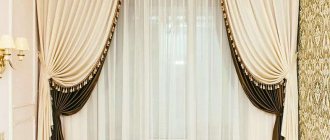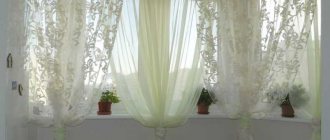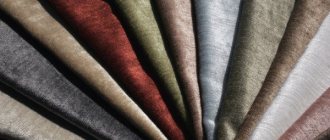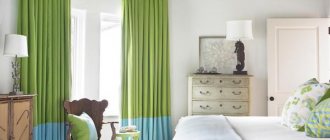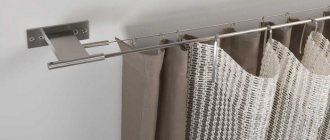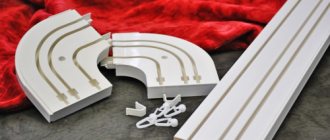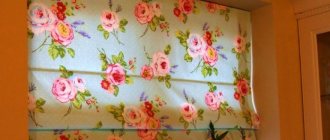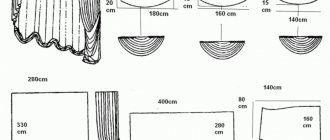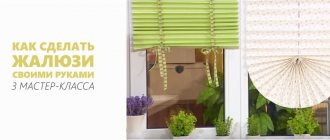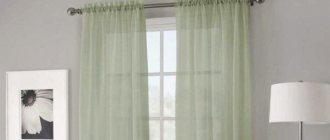French curtains are flowing lush folds and draperies. They are divided into sections. The folds run along the entire length and width of the curtains. A room decorated with such curtains immediately takes on a luxurious, majestic look.
French curtains will help place accents in the room, make it much cozier and more comfortable, and protect it from sunlight.
Window openings decorated with such curtains look chic and luxurious.
Curtain data history
Each thing has a history of creation, the country in which the product began to be produced. French curtains also have their own history of creation. It is believed that such curtains were first produced in France during the reign of Louis XIV. The 17th century is the era of classicism and baroque. Therefore, these curtains were widespread. French curtains hung on the windows of the houses of all the rich French kings, nobles, nobles, etc. But to this day they have not lost their popularity.
French curtains are fabrics decorated with many folds, which are located along the entire length of the product and remain on it, both in the raised and lowered position.
Specific items you need to know
Main types of French curtains:
- Lifting. The most common option. They can be easily raised and lowered using modern systems and mechanisms. This allows you to easily open and close the opening without damaging the curtains. When raised, such curtains form beautiful and elegant lush folds. (Their length and width are strictly according to the size of the window opening!)
- Fixed. The window is constantly closed. They cannot be raised, lowered, moved left or right. These are curtains whose folds are fixed.
At the bottom of the curtains, cords pass through the loops, which, when pulled together, form scallops.
The canvases rise to the top, forming waves and lush voluminous folds.
Types of French curtains by size:
- Long. Quite a popular option for decorating a window and a room as a whole. Beautiful, lush draperies add a little chic and luxury to the room.
A classic and quite popular design option.
Important! This is an excellent option for rooms with a large area. Such curtains will emphasize the free space and become an elegant component of the room.
- Short. Basically, curtains of this length are chosen because there is a sofa standing near the window or when the window sill goes straight into the tabletop, etc. In these cases, hang short and comfortable French curtains.
Beautifully draped fabrics add special softness and sophistication to the space.
On a note! This is a great option for rooms with a small area. Visually, such curtains will expand an already small space. Also, short French curtains are often hung in the kitchen. This emphasizes the comfort and elegance in the room.
Features of fastening and finishing
Fastening. Static curtains are hung either on curtain rods of any design in order to be moved to the side, or on Velcro fastened directly to the window frame or a special curtain rod.
Lifting curtains are hung on a curtain rod with recesses for a cord that adjusts the height, or with a ready-made lifting mechanism.
Finishing
- The lambrequin will perfectly hide the hooks for attaching the curtain to the cornice and will serve as an ideal decoration
- Fringe is the best frame for heavy fabrics; it can be used to secure the drapery below.
- Tassels will complement the cord for fixing curtains that can be moved, and medium-sized tassels will complement the lambrequin or the bottom edge of the curtains.
- Bugle beads will decorate shiny fabric. If you sew large enough beads along the bottom, they will serve as a weighting agent, a balancing element, so that the curtains do not flutter from the flow of fresh air when the window is open, but retain their appearance
Fabrics from which these curtains are made.
- Linen. This is an environmentally friendly material. Linen curtains are completely hypoallergenic. They look beautiful and elegant. Pleasant to the touch. After washing they do not settle and do not lose their original appearance. Only curtains made of this material are difficult to iron.
- Velvet. This material is especially pleasant to the touch. Its depth of color looks particularly luxurious. And because of the dense pile, such curtains have a beautiful play of light and shade.
The material is chosen based on the design features of the room.
- Veil. The material from which curtains give the room tenderness and romance. The veil looks great on its own or in combination with thicker curtains. French voile curtains look light, airy and relaxed. Therefore, such curtains will look great in the bedroom interior.
- Silk. French silk curtains shimmer beautifully in the light. They have an excellent play of colors when the sun's rays fall on them from different angles. This material is shiny, thin, but at the same time durable.
Awnings are made from well-draped materials in order to fully reveal their aesthetic capabilities.
- Organza. Curtains of this type made of organza will complement any interior. They look light, feminine, gentle, elegant, but at the same time simple and interesting. They are easy to care for, just like linen curtains.
- Atlas. Satin awnings (this is another name for French curtains) are very durable, with an incredibly smooth surface (sometimes this can turn against you, since puffs often form on a smooth surface).
Due to the reflection of light, all folds of French curtains shimmer and shine beautifully.
Possibility to combine with other curtains
A notable feature of awning curtains is the possibility of their combinations and combinations with other window design options:
- with a rigid lambrequin;
- French roller blinds with Roman and other roller curtains;
- curtains with tiebacks;
- excellent combination with decorative elements;
- together with intermediate panels located in the area of the partitions between the window openings.
It is precisely these features that are often used by modern designers in many original works and ideas. Therefore, if the question arises of how to sew French curtains, it is best to turn to such ready-made projects. After all, there may be samples sewn from two or several types of materials at once: organza tandems with an airy veil, sometimes with linen or satin.
French curtains in the living room
The living room is a room for receiving guests, so it is important to pay special attention to the choice of all parts of the interior in this room. French curtains add a touch of tenderness and sophistication to the living room. And with such curtains you can decorate both a simple room and a luxurious interior.
Curtains bring a touch of romance and sophistication to this room.
Today, French curtains decorate both elaborate and simple living room interiors.
French curtains in the nursery
Awnings will be an excellent, original and beautiful decoration for a children's room. These curtains are best suited for a girl's room. Especially if the entire interior of the room is in the style of classicism and baroque. But such curtains may not be the best option, because they collect a lot of dust.
Awnings will become an original, characteristic decoration and set the tone for the entire room.
Awnings in the bedroom
Such curtains will add chic, tenderness, romance and splendor to the bedroom. With their simple and delicate design, the curtains will complement any style in the bedroom. You will be pleased to be in such a room. After all, French curtains set your body up for rest and sleep.
With their lyrical and delicate design, they create a special atmosphere and emphasize good taste.
French curtains in the kitchen
The kitchen is such a cozy place where you can talk with family and friends over a cup of hot tea. It is best to hang short awnings in this room. French curtains in the kitchen will add pomp and at the same time lightness.
Both short curtains up to the window sill and long options will look appropriate here.
Awnings, with their lush and luxurious folds, will perfectly complement any kitchen interior and add charm, wealth and pomp to it.
Operating principles of cornices
Cornices for French curtains come in several types:
- open type;
- closed type;
- with chain drive;
- with cord drive;
- with electric drive.
Construction and operation of open cornices
The cornice body is attached to the wall or ceiling through additional brackets. Carriages with blocks for winding cords are attached to the lower part of the body. A square-section metal rod passes through the holes in the blocks of all carriages, the ends of which are fixed in the final bushing and the chain drive bushing. To raise the canvas, you need to pull the chain with a weight attached to the bottom. The chain rotates the chain drive bushing and the rod attached to it. Rotation is transmitted through the bar to carriages and blocks. When the blocks rotate, the cords are wound and retracted, and, as a result, the curtain fabric rises and lowers.
Open cornice
Construction and operation of closed cornices
The device is a cassette made of aluminum or plastic profile with end caps, which is attached to the wall or ceiling using additional brackets. Inside the cassette there is a metal rod with cord winding drums attached to it with screws. The ends of the rod are secured in an end cap on one side and in a chain-driven bushing on the other side of the cassette.
To raise or lower the curtain, you need to pull the chain, which rotates the chain mechanism bushing and the cassette rod.
Closed cornice
Construction and operation of curtain rods with cord drive
The device is a housing made of a metal or plastic profile, mounted on a wall or ceiling. Brackets with cords passed through them are inserted into the lower longitudinal slot of the profile. Some ends of the cords, passed through the vertical drawstrings on the curtain, are fixed to the lower edge of the canvas, the other ends, passing through the holes in the brackets, are collected into a single bundle of cords in the block. The movement of the bundle of cords under the influence of the weight of the curtain is restrained by a limiter that regulates the amount of rise and fall of the curtain fabric.
Curtain rod with cord drive
How to sew these curtains with your own hands
Necessary materials:
- sewing machine;
- pins;
- scissors;
- soap or chalk;
- textile;
- threads to match the color of the fabric.
Awnings with their exclusivity will add a picturesque image to the interior of a certain style.
But before you buy fabric, you need to measure the window. The resulting width must be multiplied by one and a half, and the length by two. This result indicates how much fabric will be needed. But you still need to make seam allowances (2-3 cm).
French curtains are the embodiment of classics.
Operating procedure:
- First you need to process the edges of the fabric. Having spread the fabric on a smooth, flat surface (on a table or on the floor), make double folds (about 1 cm wide) on the sides and stitch them.
- Along the bottom edge you also need to make a double fold, but already 1.5 cm wide. Then stitch.
- The next step is to mark the scallops. Important! They need to be placed at an equal distance from each other across the entire width of the panel. (If you look at the table above, you can see that the width of the scallops directly depends on the width of the fabric. Therefore, based on the table, make markings).
- Then, using pre-prepared fabric, decorate the curtain drawers. To do this, sew these panels of fabric to the marking place (while bending them by 2-3 cm).
Graceful flowing accordion draperies will fit perfectly into any interior style. - You need to thread special cords into the finished drawstrings (you can use braid, ribbon or decorative rope to match the color of the curtains). Later, when the curtains are ready, you can use this cord to adjust the length of the curtains.
- Also, if you buy special rings, you can hang festoons on them. The rings are attached to the fabric at a distance of 15-20 cm from each other along the entire length of the panel.
- The cord should allow you to easily adjust the height of the curtain. When lifted, the scallops should form light and airy semicircular folds. A thick braid must be sewn to the top edge of the curtains. To use it to attach curtains to a rod.
- After securing the curtains to the rod/cornice, adjust the length of the curtains.
French curtains will add celebration, style, sophistication, elegance and splendor to the interior.
That's all! Luxurious DIY French curtains at home are ready!
Which color is better to choose?
The color scheme of the textile product depends on the surrounding decor. In this case, they start from the following interior elements:
- furniture;
- wallpaper;
- accessories.
Interior
In dark rooms it is preferable to use light French tulle, and in spacious rooms it is permissible to use different ones, including dark and heavy ones. To make the heat easier to bear in sunny weather, it is not recommended to use bright sunny colors of fabric for a south-facing window.
Advice: it is advisable to use a plain fabric or a canvas with a barely noticeable pattern, since a clearly defined pattern in a large number of folds is lost and ripples.
The easiest way to sew French curtains with your own hands
Step by step instructions.
- You need to measure the window. The resulting width must be multiplied by one and a half, and the length by two. This result indicates how much fabric will be needed. But you still need to make seam allowances (2-3 cm).
- The purchased fabric should be soaked in warm water, wrung out, allowed to dry and ironed. All these procedures must be performed so that the fabric does not shrink in the future.
- Then you need to make a double fold (1-1.5 cm) and stitch all the edges.
The elegant design of French curtains goes perfectly with the simple and laconic interior of Provence.
- Mark the drawstrings so that there are equal spaces between them. Then on the front side you need to sew a special braid for French curtains (but if you don’t have one, you can use regular fabric 3 cm wide).
- A decorative rope/cord, ribbon or braid must be inserted into the side seams. Next, the drawstrings are formed. We fasten the cords at the top (you can stitch them), and there are free ends at the bottom. You can use the cord to adjust the height of the curtains.
- To keep the curtains vertical, you can sew in special weights.
Awnings will especially emphasize the freedom of style, create real comfort and add soft diffused lighting to the entire room.
That's all! This is the easiest way to create French curtains with your own hands!
How much to retreat, how to sew and where to pull?
After attaching the cord, the next step is to install the rings.
Modern fittings are made of metal and plastic. The first material is considered more durable, but for light curtains it is still better to choose plastic. The places where the rings are attached should be marked with chalk, a simple pencil or pins.
Beginners make a common mistake: the rings that are located at the bottom of the canvas are lowered very low. Correctly positioned lower rings of a French curtain will always be 5 cm higher than its edge. Another mistake is the distance between the rings being too large or small, or more precisely, between their rows.
The best option is a gap of 30 cm. It is also important to correctly measure the distance between the upper rings and the braid. The standard option is 12 cm - this is how much you need to retreat from the top edge of the fabric before you start sewing on the top row of fittings.
French curtains are perfect for a classic interior with antique furniture.
The process of attaching the rings themselves to French curtains is also important. Correctly fasten the rings with just a few stitches; only two knots are made on the thread. After sewing on all the rings, they proceed to pulling out the cords from the braid.
It is imperative to monitor the uniformity of the folds during this operation and correct it. As soon as the French curtains reach the required length for the window, they need to be fixed. To perform this operation, the cords are secured at the top edge and neatly tied together.
The size of the border should be equal to the length of the cornice. To prevent the knots of the cords from becoming too unfastened, it is necessary to take measures: the knots are tied as close as possible to the curtain fabric - and the problem is solved. All that remains is to cut off the excess sections of the cords and move on to the next stage of work - installation of the product.
Caring for French curtains
Of course, sewing such curtains with your own hands is only half the battle. The main thing is to properly care for them. Then French curtains will serve you for a long time. Awnings are truly beautiful curtains. They add luxury, richness, tenderness, and romance to the room. They have many advantages. But there are also disadvantages. The main and only disadvantage of such curtains is that a lot of dust often accumulates in the numerous folds.
French curtains have a fairly rich range of colors.
The presence of purple decor on the windows in the room stimulates inspiration and creative thinking.
- Small stains on curtains can be removed with a damp cloth.
- You can clean the folds of curtains from dust with a vacuum cleaner. Just be very careful!
- French curtains made of tulle and organza can be machine washed in the “delicate wash” mode.
- Velvet curtains should be dry cleaned.
- Such curtains cannot be ironed. It is better to hang them a little damp and they will take the desired shape themselves.
A well-chosen design will make the window in each room original and interesting.
